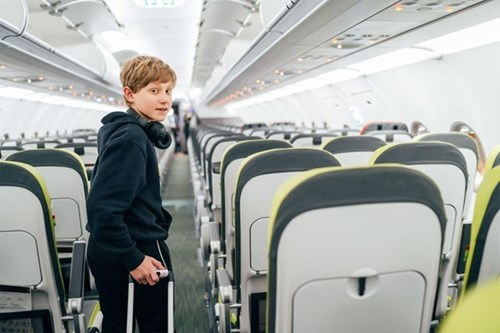How old do children have to be to fly alone?

Travelling alone can seem daunting for adults, but sometimes children have to do it too. However, the fact that you won’t be on the plane with them doesn’t mean you can’t help them out. Whether they’re a seasoned flyer or they have first flight jitters, there are ways you can prepare your child to fly unaccompanied without a hitch.
Keep reading to learn more.
What age can children fly alone?
There is some variation between airlines on the exact ages of children who can and cannot fly alone. However, generally speaking, any child between the ages of five and 12 can fly with a chaperone service (if your airline of choice provides one). Children over the age of 12 can usually fly without a chaperone, but it’s always best to check with your airline. Once your child is 16 or older, in most cases they are considered an adult with respect to flying arrangements.
Children under the age of five cannot fly unaccompanied on most airlines even with a chaperone service, so will need to be escorted by a responsible adult.
Do I have to book my child as an unaccompanied minor?
The simple answer is yes. For flights that provide an unaccompanied minor service, you must book your child in as such if they are within the age range for your airline. If your child doesn’t have the appropriate booking, they may not be allowed to board the plane. Some airlines only allow accompanied minor bookings on certain flight routes, with additional restrictions on flights that involve stopovers or transfers - always check with the airline in good time before your child’s trip.
Unaccompanied minor bookings often come with a specific added charge on top of the price of an airline ticket. Depending on your airline of choice, airline tickets may be charged at the same rate as an adult’s ticket.
What documents does an unaccompanied minor need to fly?
Every airline has different regulations, but at the bare minimum, you’ll need to provide documentation detailing the responsible adults who will be picking up and dropping off your child. This includes identifying documents such as a driving licence or passport. Responsible adults will need to bring matching ID to the airport at both ends of the journey in order to prove that they are the nominated guardian before they will be allowed to leave with the young flyer.
It’s also advisable to send your child with any medical information that may be required. For example, if your child has allergies or takes medications, this could be vital information to keep them safe in the event of illness or injury during their trip. As well as medical information, emergency contact information is also advisable. Your airline should take emergency contact details when you book your child in, but having the details to hand with your child can help save time.
Another form of documentation that you may opt for is travel insurance. This can help to cover you in case anything goes wrong during your child’s trip as a whole, not just on the flights. It can also give you a little extra peace of mind. Travel insurance may be more expensive for children flying alone, but prices vary between insurance brokers.
For more information about the required documentation your child needs to fly, check with your chosen airline.
Checking in an unaccompanied minor
One thing that can help to settle children’s nerves about flying alone is to know what to expect when they get to the airport. If needed, you can access travel assistance to ensure the process goes as smoothly as possible. Fast-track security can also be booked in advance in order to get your child and their luggage through all the necessary checks quickly.
Children must be accompanied by a responsible adult through check in. A member of the cabin crew will then come to collect your child to take them to the plane. When flying alone, children are given priority boarding. This is so that cabin crew can get them settled on the plane and answer any questions they may have before the rest of the passengers board.
Remember to have all the documentation you need, including ID, ready when you arrive at the airport. You’ll need to confirm the details of the adult responsible for collecting your child at the other end of the flight. Then, once you have your child’s boarding pass, go to the right gate at least 30 minutes before departure time.
It’s important that you remain at the airport until the flight has departed just in case the plane needs to return to the gate for any reason. Please keep this in mind when booking a parking space for pick up and drop off of your child.
On arrival at the destination airport, the cabin crew will not hand your child over into the care of anyone who isn’t listed as a receiver on your documentation. If you are at all unsure of who will be able to pick up your child, it’s important to list all options when booking for your child so they can be safely collected from the airport.